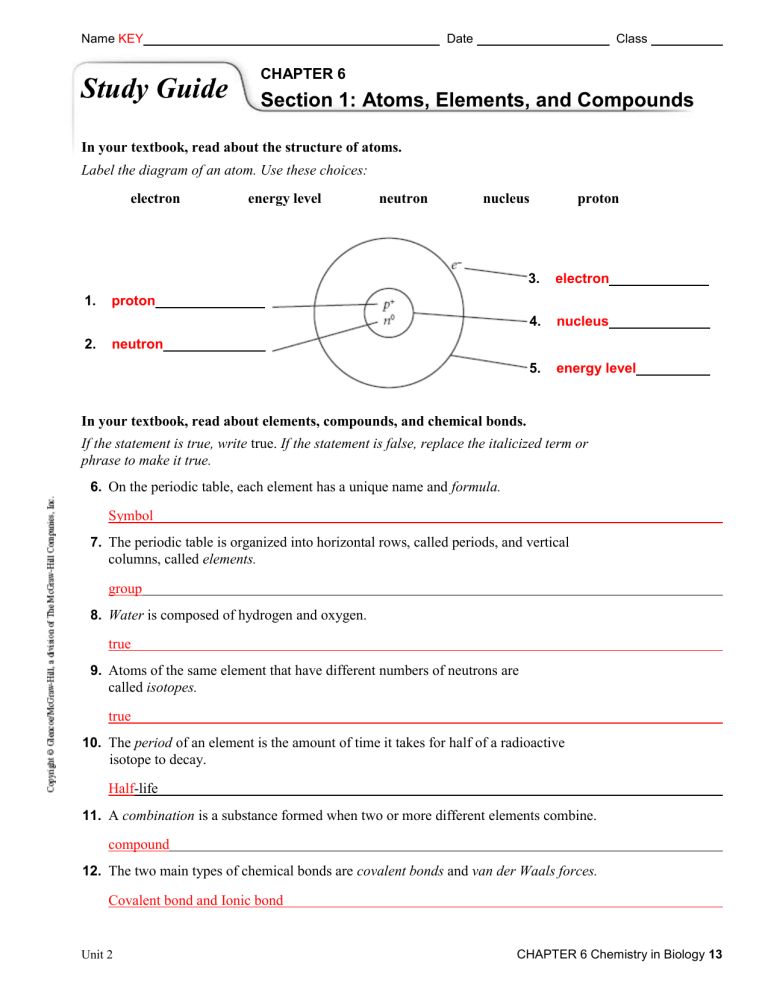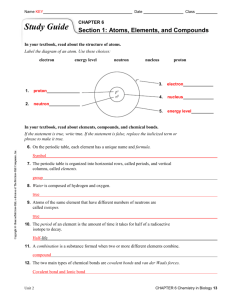Chemistry in Biology Study Guide: Atoms to Building Blocks
advertisement

Name KEY Study Guide Date Class CHAPTER 6 Section 1: Atoms, Elements, and Compounds In your textbook, read about the structure of atoms. Label the diagram of an atom. Use these choices: electron 1. 2. energy level neutron nucleus proton 3. electron 4. nucleus 5. energy level proton neutron In your textbook, read about elements, compounds, and chemical bonds. If the statement is true, write true. If the statement is false, replace the italicized term or phrase to make it true. 6. On the periodic table, each element has a unique name and formula. Symbol 7. The periodic table is organized into horizontal rows, called periods, and vertical columns, called elements. group 8. Water is composed of hydrogen and oxygen. true 9. Atoms of the same element that have different numbers of neutrons are called isotopes. true 10. The period of an element is the amount of time it takes for half of a radioactive isotope to decay. Half-life 11. A combination is a substance formed when two or more different elements combine. compound 12. The two main types of chemical bonds are covalent bonds and van der Waals forces. Covalent bond and Ionic bond Unit 2 CHAPTER 6 Chemistry in Biology 13 Name Study Guide Date Class CHAPTER 6 Section 2: Chemical Reactions In your textbook, read about reactants and products. Fill in the blanks with the correct number of molecules to balance the chemical equation. C6 H12 O 6 + ______ O2 (1) ______ ______ CO 2 + H 2O (2) (3) Respond to each statement. 4. State the principle that explains why there must be the same number of atoms of each element on each side of an equation. conservation of mass; Matter cannot be created or destroyed. 5. Identify which number indicates the number of atoms of each element in a molecule of a substance. the subscript number to the right of each element 14 Chemistry in Biology CHAPTER 6 Unit 2 Name Date Class CHAPTER 6 Study Guide Section 3: Water and Solutions In your textbook, read about water’s polarity. Label the diagram. Use these choices: covalent bond hydrogen bond slightly negative end slightly positive end 1. slightly negative end 2. slightly positive end 3. hydrogen bond 4. covalent bond In your textbook, read about mixtures with water. For each statement below, write true or false. true 5. A mixture is a combination of two or more substances in which each substance retains its individual characteristics. false 6. A suspension is a mixture that has a uniform composition throughout. false 7. In a mixture, the solvent is the substance that is dissolved. true 8. A mixture of sand and water is a heterogeneous mixture. false 9. A suspension is a homogeneous mixture in which water is mixed with a substance that does not dissolve in it. In your textbook, read about acids and bases. Use each of the terms below only once to complete the passage. acids bases biology buffers hydrogen ions neutral pH Substances that release hydrogen ions when dissolved in water are called (10) acids . The more (11) hydrogen ions a substance releases, the more acidic the solution becomes. Substances that release hydroxide ions when dissolved in water are called (12) bases . Acids and bases are key substances in (13) biology . The concentration of hydrogen ions in a solution is called (14) pH . Pure water is (15) neutral value of 7.0. (16) buffers and has a pH are weak acids or weak bases that can react with strong acids or strong bases to keep the pH within a particular range. Unit 2 CHAPTER 6 Chemistry in Biology 15 Name Date Class CHAPTER 6 Study Guide Section 4: The Building Blocks of Life In your textbook, read about the building blocks of life. For each statement below, write true or false. true 1. Carbon atoms can bond together in straight chains, branched chains, or rings. false 2. Large molecules containing carbon atoms are called micromolecules. false 3. Polymers are molecules made from repeating units of identical organic compounds that are linked together by hydrogen bonds. true 4. Carbon is a component of almost all biological substances. false 5. Macromolecules can be organized into vitamins, lipids, proteins, and nucleic acids. In your textbook, read about carbohydrates, lipids, proteins, and nucleic acids. Label the diagrams. Use these choices: saturated fat, unsaturated fat. 6. saturated fat 7. unsaturated fat Complete the table by checking the correct column(s) for each description. Description Carbohydrate Lipid Protein X 8. Stores coded genetic information X 9. Makes up fats, oils, and waxes in biology X 10. Makes up muscles, skin, and hair X 11. Forms double-helix structures X 12. Is made of amino acids 13. Includes glucose, lactose, sucrose, and glycogen 14. Stores energy and is part of membranes 15. Contains peptide bonds 16 Chemistry in Biology CHAPTER 6 Nucleic Acid X X X Unit 2 Complete the table below. Polymer Monomer Elements Example Function Carbohydrates Monosaccharide C1H2O1 Mono: glucose Di: sucrose Poly: starch, cellulose, glycogen, chitin Cholesterol Phospholipids triglyceride Energy Lipids Glycogen Fatty acids CHO Proteins Amino Acid CHON(S) Enzymes Muscle Hair/nails blood Speed up rxn Movement Structural transport Nucleic Acids Nucleotide CHONP DNA RNA Genetic information Energy Hormones Part of cell membranes 1. At room temperature, saturated fats are at what state? List 2 saturated fats. Solid – butter, animal fat, lard 2. At room temperature, unsaturated fats are what state? List 2 unsaturated fats. Liquid – olive oil, corn oil, peanut oil 3. What is a monomer and polymer? Monomer – a single unit of a polymer Polymer – a long chain of monomers 4. What reaction builds a polymer? Dehydration reaction 5. What reaction breaks down a polymer? Hydrolysis 6. Name the 3 polysaccharides we talked about in class. Where are the three found? Starch – plants Cellulose – plants Glycogen – animals Chitin – exoskeleton of arthropods 7. What is a peptide bond? A bond between two amino acids 8. How can an enzyme be denatured? When the temperature, pH or salinity levels go outside of the normal range for the enzyme. 9. What are the four levels to building a protein? Primary – sequence of amino acids Secondary – forms α helices or β pleated sheet Tertiary – how the polypeptide interacts or folds upon itself Quaternary – interactions between other polypeptides



